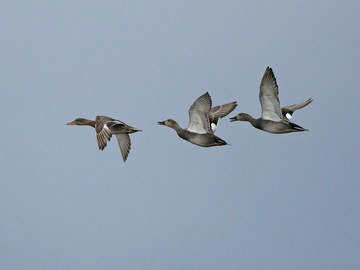
Gadwall © Steve Round
Gadwalls were found wintering in 54 tetrads, rather more than the 39 with birds recorded during the breeding season, the extra sites being especially in the west and south-west of Cheshire, and SJ86 and SJ87 in the east. Birds were recorded in similar habitats to the breeding season, with 59% on lakes, reservoirs and sandpits, although with a higher proportion (21%) on ponds or small waterbodies, perhaps suggesting that, without the demands of a growing brood, even ponds and small waters can provide the food to satisfy their needs. Two birds seen on the Mersey in SJ37Z and in SJ58G were the only estuarine birds.
Between one-third and a half of the Gadwalls wintering in Britain and Ireland originate in eastern Europe, normally as far as the Baltic States, supplementing the largely resident breeding birds and their progeny (Migration Atlas). However, the movements of Cheshire and Wirral birds are not known and perhaps some of them could, like Icelandic and Scottish breeders, winter in Ireland.
The British wintering population has risen ten-fold in the last forty years, leading to frequent revisions in the qualifying figures for the national or international importance of a site. Nowhere in the county currently approaches the threshold for international importance of a five-year peak mean of 600 birds, but Woolston is in the top thirty British sites and is nationally important. This species, however, seems to have a history of erratic fluctuations in numbers at a site, with WeBS counts sometimes rising or falling dramatically from one year to another, for reasons that are not understood (Banks et al 2006).
It was only in 1989 that the first three-figure count was recorded anywhere in the county, at Woolston and at Rostherne Mere, and Rostherne was Cheshire’s premier Gadwall wintering site until 1997 as Woolston no.3 bed recovered from the drainage in 1991, emphasising both the vulnerability of birds being too concentrated on one site, and the value of having alternative suitable refuges. Numbers at Woolston usually peak in August or September, averaging around 250 (Banks et al 2006) – the 470 on 19 September 2004 was a county record – but the highest count during this winter Atlas was 160 birds on 8 February 2006, most of them on the Loop of no.4 bed, an area specially created for nature conservation. Other than parts of the Woolston complex, the only sites with significant counts, just over 50 birds each, were Moore Nature Reserve (SJ58X) and Abbots Moss (SJ56Z).
These numbers would have been unthinkable to Cheshire’s early ornithologists. Coward described Gadwall as a rare visitor to the Dee estuary, and knew of only two records, in March 1845 and October 1908. It appears that the first in winter was one at Rostherne on 5 December 1936 (Boyd 1946). Bell traced over fifty records after 1944 in every month except June, but mainly in April, September and October, and they were only present in very small numbers, with the maximum ever seen together just four birds (Bell 1962).Sponsored by James Coyne

